|
Категории
|
Old Paper mill near SamarkandAt the beginning of IX century an important branch of craftsmanship in Samarkand was the manufacture of writing paper. The study of the history of Samarkand paper sheds light on the rich history of culture of the peoples of the region. In July, 751 years on the Taraz River (Talas) Chinese troops invaded the territory of Central Asia. But Samarkand leader Abu Muslim sent his troops against them, defeated the foreigners, and captured twenty thousand Chinese. Among the Chinese men had a lot of people from families of artisans, including those involved in the production of paper. Apparently to save their lives, they reveal all the secrets of technology to local artisans. From that time, ie starting from the VIII century, Samarkand became the paper manufacture, and at the beginning of IX century the production of writing paper is considered an important sector of crafts.
Written sources of the period noted in the high quality of Samarkand paper. According to the tenth century Arab historian Makdisi, “Khorezm bows, Shash dishes and Samarkand paper had no equals”. A high rating to the medieval masters is given Zahiriddin Babur in his famous biography "Baburname": "... The best paper in the world is derived from Samarkand, all the water for paper mills comes from Coni Gil. Koni Gil is on the banks of the Siyoh-Ob, this stream is also known as Obi-Rahmat ... ". Many years later the excellent quality of Samarkand paper marked A. Vamberi, a renowned scholar, orientalist, traveler, ethnographer and linguist, who visited Central Asia in 1863: "Paper, manufactured in Bukhara and Samarkand, - he wrote - to enjoy throughout Turkestan and the adjacent countries of high reputation." Over thousands of years, craftsmen of Samarkand, "kogozgars", fabricate the world's best paper that has a smooth surface, durable, and most importantly - absorbs little ink. Manufacturing techniques have been developed various types of paper: · "Samarkand Sulton kogozi" (Sultan grade) differed in white, the subtlety and gentleness. · "Samarkand shoyi kogozi " (Silk) was also very smooth, fine, but the light yellow color. · "Mir-Ibrahimi" had a watermark in the form of a white ring. · To produce grade "Nimkanop" (semi-hemp) silk waste mixed with bast fibers. Color turns brown. During the reign of Amir Temur paper production has continued to be one of the main branches of handicraft. It is known that at a later time, at the beginning of the XVIII century, in Samarkand and its suburbs are 42 workshops for the production of paper. They were discovered in Kokand, Bukhara, Tashkent. As a raw material used cotton, silk and mulberry tree bark. Begun internecine wars of the rulers of Bukhara and Samarkand, and as a consequence of the invasion Djungars (Kalmyk) and Iranian forces have caused a severe economic crisis in the region. Samarkand and its suburbs were deserted. Volumes, and most importantly, the quality of paper produced is gradually decreased. Surviving in these troubled times the master-papermaker had to move to other areas. Thus, the center of paper production has shifted to Kokand and despite more than a modest amount and quality of products, the industry crafts existed here before XX c. What is the difference Samarkand paper from similar products of China and Japan? According to Masters, the commodity basis of Samarkand paper is served a mulberry bark - a mulberry tree growing in Central Asia throughout the Silk Road. This type of paper is different characteristic silky surface and a nice soft shade of ocher, less tiring your eyes when reading the contrasting black and white tie of ancient calligraphy.
After solving organizational problems in the vicinity of Samarkand at the village Konigil in courtyard of Zarif Mukhtarov opened a small workshop, the founders of which were master potters Zarif and Islam Mukhtarov’s - the sons of Honored Artist of Uzbekistan Abdurakhim Mukhtarov.
The finest mulberry shoots are cut from the onset of the first frost. Since these skin peels and separated cambium - a soft porous layer who, after years of drying, again soaked and boiled for several hours.
Then the material is again dissolved in water, filtered through the finest sieve and formed it lists gently squeezed out, dried in the sun. At the end of the paper surface is polished sea shell on a smooth marble.
One of the most ancient cities - Samarkand with its rich history and material culture is the enduring value of the entire human civilization. In light of this, the revival of the lost elements of urban life, even the limited interests of the tourism business, is an important task, which was done Mukhtarov brothers.
In 2002, the German artist Wolfgang Timman organized a solo exhibition "From the History of Writing" which was to be held in major centers of culture of the Middle East, as well as the cities of Europe. The exhibition was opened in Samarkand. Since it is the Samarkand paper, according to the artist, has become a major factor in the development of writing, printing and sharing of information for most countries.
Saida Kayumova, Lead researcher of Department of the history and ethnography of the Samarkand State Museum-Reserve |
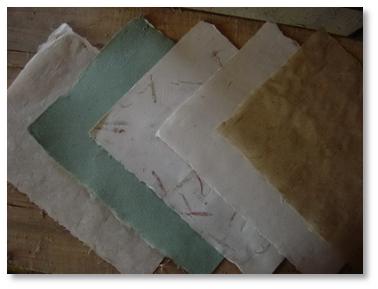 Samarkand paper with the onset and the end of the Middle Ages dominated the eastern and western markets. Different varieties of these products for a thousand years, from VIII to XIX centuries, famous not only in Central Asia but also in the Middle East and Europe - Spain, France and Germany. Most of Persian and Arabic manuscripts IX-X centuries was performed at the Samarkand paper.
Samarkand paper with the onset and the end of the Middle Ages dominated the eastern and western markets. Different varieties of these products for a thousand years, from VIII to XIX centuries, famous not only in Central Asia but also in the Middle East and Europe - Spain, France and Germany. Most of Persian and Arabic manuscripts IX-X centuries was performed at the Samarkand paper. In 1995, UNESCO decided in Kagan, an international conference dedicated to the preservation of historical monuments. Much attention was paid to the development of ancient crafts in the aspect of applied art, including, it was proposed to revive the medieval paper production. Trying to solve the problem voiced by the scale of Samarkand was made chairman of the Association "Konigil Meros" Zarif Mukhtarov. After a detailed study of relevant literature, as well as written sources dating from that period in museums and libraries during the long experimental search for the master was able to restore an ancient technology. It was found that the most suitable raw material for the production of Samarkand paper is a Central Asian mulberry tree – “balkhi”. The most high-quality material is prepared in the winter.
In 1995, UNESCO decided in Kagan, an international conference dedicated to the preservation of historical monuments. Much attention was paid to the development of ancient crafts in the aspect of applied art, including, it was proposed to revive the medieval paper production. Trying to solve the problem voiced by the scale of Samarkand was made chairman of the Association "Konigil Meros" Zarif Mukhtarov. After a detailed study of relevant literature, as well as written sources dating from that period in museums and libraries during the long experimental search for the master was able to restore an ancient technology. It was found that the most suitable raw material for the production of Samarkand paper is a Central Asian mulberry tree – “balkhi”. The most high-quality material is prepared in the winter.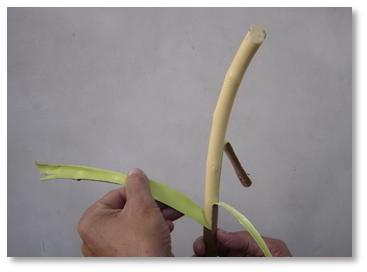 Modern masters managed to uncover the secret of such a high quality of Samarkand paper, namely, the secret of the raw materials used and unique manufacturing technology.
Modern masters managed to uncover the secret of such a high quality of Samarkand paper, namely, the secret of the raw materials used and unique manufacturing technology.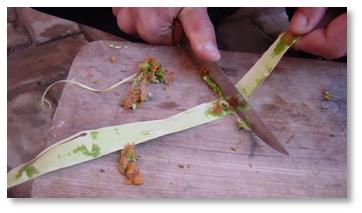 The resulting pulp is carefully crushed with wooden sticks to the formation of very thin filaments.
The resulting pulp is carefully crushed with wooden sticks to the formation of very thin filaments. 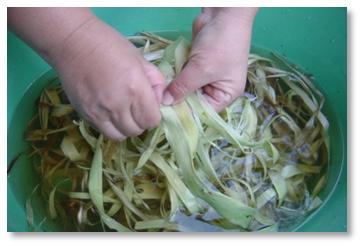 Master polisher (“mukrakash”) should own the perfect craft. There is every reason to believe that it is through his art Samarkand paper was valued so highly.
Master polisher (“mukrakash”) should own the perfect craft. There is every reason to believe that it is through his art Samarkand paper was valued so highly.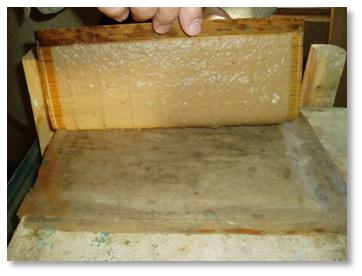 Now Uzbek miniaturists have the opportunity to create their own works on paper, which used the medieval authors. Products from the village workshop Konigil is also used in Japan to the restoration of ancient manuscripts and rare editions. Samples of modern Samarkand paper is enough demand in the tourism industry of the country. Text of the menu, original souvenirs, canisters with a scroll of Samarkand paper, various oriental masks, for example girl with small braids or a smiling boy in the national head-dress - all done in the studio of Zarif Mukhtarov "Konigil-Meros". Art and Techniques of Samarkand paper from year to year is improving, as evidenced by diplomas and certificates obtained at the international exhibitions that were held in Kazakhstan, the Netherlands and other countries.
Now Uzbek miniaturists have the opportunity to create their own works on paper, which used the medieval authors. Products from the village workshop Konigil is also used in Japan to the restoration of ancient manuscripts and rare editions. Samples of modern Samarkand paper is enough demand in the tourism industry of the country. Text of the menu, original souvenirs, canisters with a scroll of Samarkand paper, various oriental masks, for example girl with small braids or a smiling boy in the national head-dress - all done in the studio of Zarif Mukhtarov "Konigil-Meros". Art and Techniques of Samarkand paper from year to year is improving, as evidenced by diplomas and certificates obtained at the international exhibitions that were held in Kazakhstan, the Netherlands and other countries.














